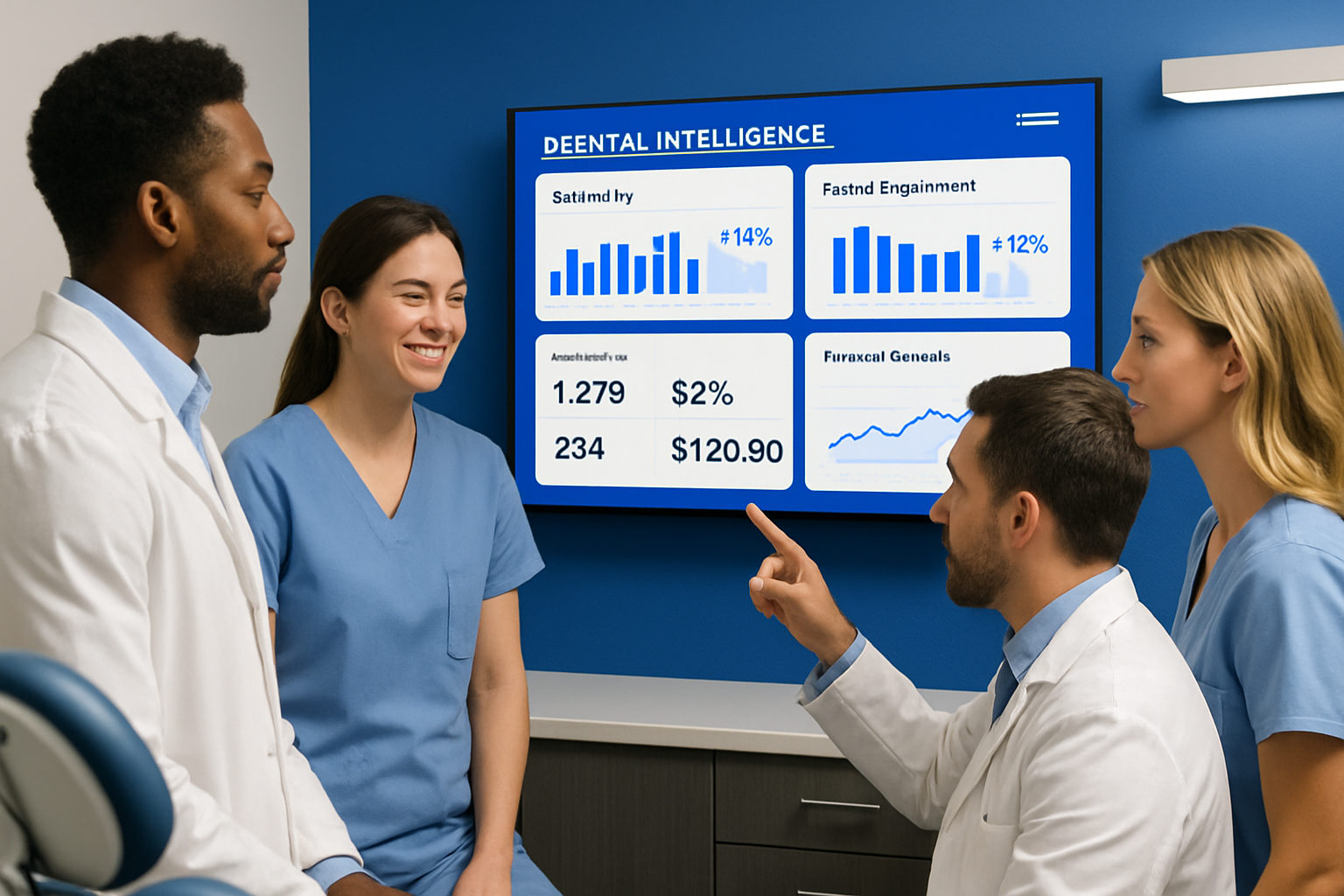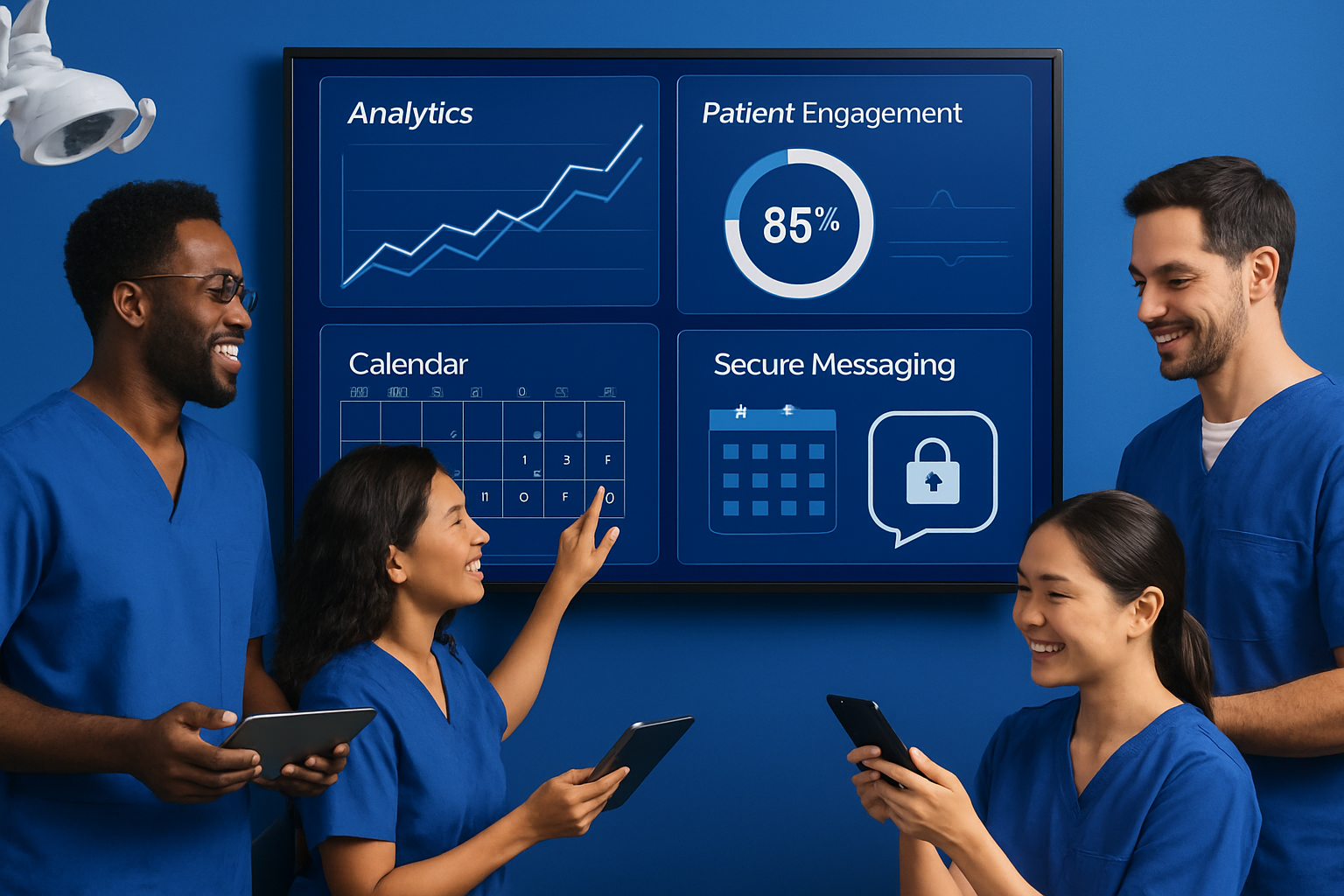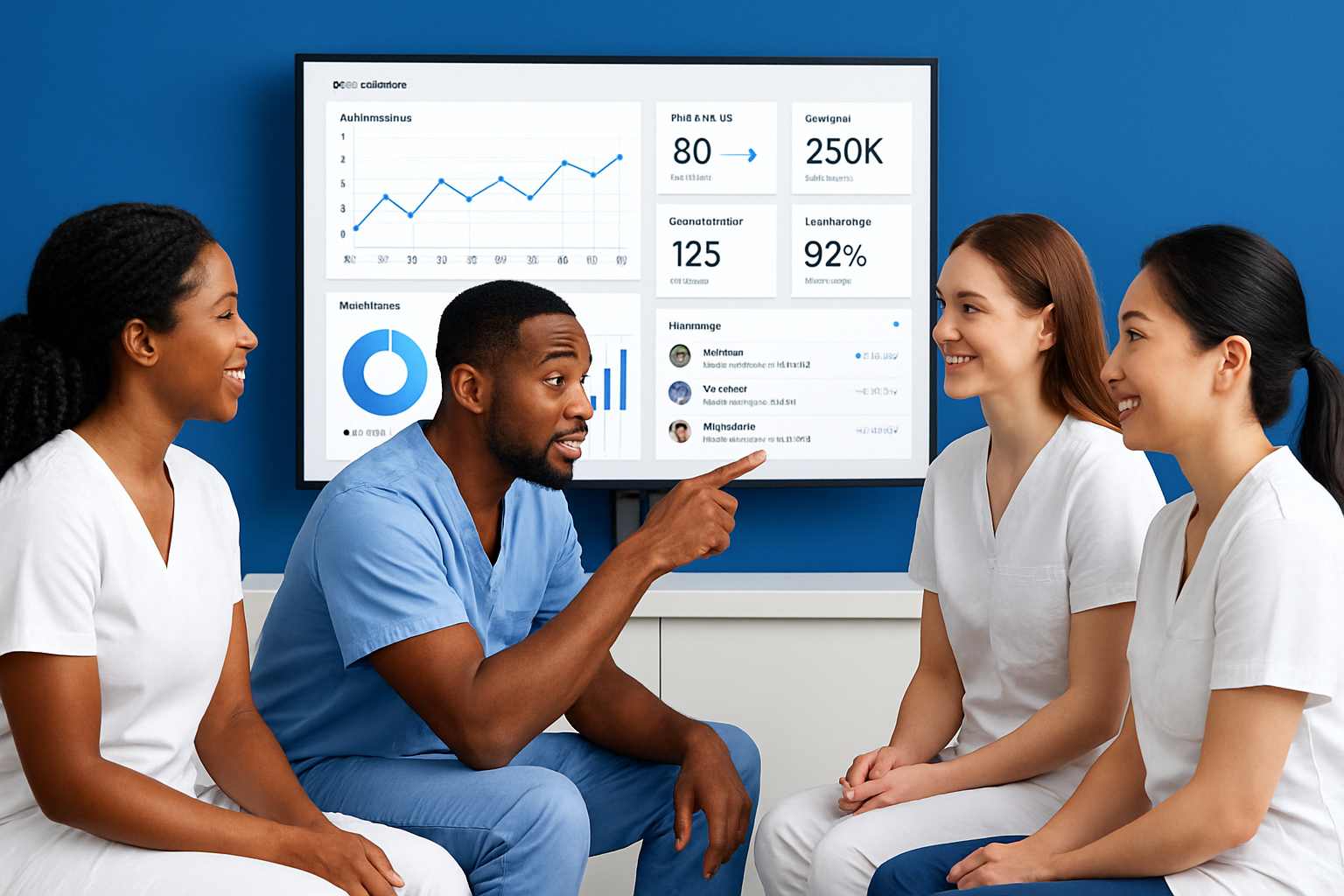In 2025, dental practices face more competition, higher patient expectations, and rapid technological change than ever before. Adapting quickly is no longer optional—it's essential for survival and growth.
This guide is your roadmap to unlocking practice success with dental intelligence. We'll cover what dental intelligence is, why it matters, and how it transforms every aspect of your workflow.
You'll discover the benefits, key features, step-by-step implementation, and future trends shaping the industry. Ready to outperform competitors? Dive in and learn how data-driven strategies can boost your efficiency, patient care, and profitability starting today.
Understanding Dental Intelligence: Definition and Core Concepts
Dental practices are no longer just about clinical care—they’re data-driven enterprises. So, what exactly is dental intelligence, and how does it differ from basic analytics?
Dental intelligence refers to a comprehensive system that transforms raw practice data into actionable insights, helping dental teams make smarter, faster decisions. Unlike simple analytics, which might only track production numbers or appointment counts, dental intelligence platforms integrate and analyze data across every aspect of a practice. For a deeper dive into these concepts, see this dental analytics and intelligence overview.
The Evolution from Traditional Management to Data-Driven Systems
Traditionally, dental practices relied on manual tracking and basic software to manage schedules and finances. Over time, the industry has shifted toward more sophisticated, data-driven systems. This evolution allows for real-time decision-making, predictive modeling, and personalized patient communication—all powered by dental intelligence.
Types of Data Collected by Dental Intelligence Tools
Modern dental intelligence platforms gather a wide range of data, including:
- Production data: Tracks revenue, procedures, and provider performance.
- Scheduling data: Monitors appointment flow, cancellations, and open slots.
- Patient engagement: Measures recall compliance, survey responses, and communication history.
- Financials: Analyzes collections, outstanding claims, and account receivables.
By capturing these metrics, dental intelligence tools help practices identify inefficiencies and opportunities for growth.
Real-World Examples of Dental Intelligence in Action
Imagine a dashboard that offers real-time analytics on hygiene production, or a system that predicts which patients are most likely to cancel appointments. Dental intelligence can also track patient retention, highlighting trends in reappointments and satisfaction.
For example, predictive scheduling tools can automatically fill last-minute openings by identifying patients likely to accept quick appointments. Automated reporting keeps teams informed about key performance indicators without manual effort.
Core Components of Dental Intelligence Platforms
The backbone of any dental intelligence solution includes:
| Component | Description |
|---|---|
| Dashboards | Visualize live data for quick decision-making |
| KPIs | Track metrics like production, case acceptance |
| Automated Reporting | Sends regular updates to teams |
| Benchmarking | Compares performance to industry standards |
These features go far beyond what standard dental software offers.
Comparing Dental Intelligence to Standard Dental Software
Standard dental software handles scheduling, billing, and records management. In contrast, dental intelligence platforms integrate with these systems and add layers of advanced analytics, automation, and benchmarking. This means practices can spot trends, predict growth, and proactively address challenges.
Consider this: Industry reports show that practices using dental intelligence experience 20-30% higher revenue growth than those relying on basic management tools.
Why Dental Intelligence Is Essential in 2025
In 2025, patient expectations are higher, competition is fiercer, and operational costs are rising. Dental intelligence empowers practices to stay ahead by optimizing workflows, enhancing patient care, and driving profitability. Adopting these tools isn’t just a trend—it’s a necessity for future-ready practices.

The Business Impact of Dental Intelligence Tools
Dental intelligence is transforming how dental practices operate, compete, and grow. By harnessing advanced analytics and automation, practices can unlock new levels of efficiency, patient satisfaction, and profitability. Let’s explore the concrete business impacts of dental intelligence in 2025.

Enhancing Practice Efficiency
Dental intelligence tools streamline operations by automating routine tasks and optimizing workflows. Imagine a front desk without constant phone calls for appointment reminders. With automated confirmations and digital patient forms, staff spend less time on administrative chores.
Key efficiency boosters include:
- Automated appointment reminders that reduce no-shows significantly.
- Digital intake forms that save time during patient check-in.
- Real-time schedule adjustments that fill last-minute cancellations.
These features free up staff to focus on patient care and more complex tasks. Studies show that practices using dental intelligence report up to a 40% reduction in no-shows, directly impacting the bottom line. By reallocating resources and minimizing manual work, teams can serve more patients and boost overall productivity.
Improving Patient Experience and Retention
Personalized, timely communication is the backbone of patient loyalty. Dental intelligence platforms enable practices to tailor messages for each patient, from appointment reminders to targeted recall campaigns.
For example:
- Patients receive tailored treatment reminders based on their history.
- Satisfaction surveys are sent automatically after visits, encouraging feedback.
- Targeted recall campaigns help bring overdue patients back for care.
This level of engagement leads to higher satisfaction and trust. Industry benchmarks show that patient retention rates can increase by 15% when leveraging personalized communication. Plus, happy patients are more likely to leave positive online reviews, further attracting new clients. Dental intelligence bridges the gap between clinical care and exceptional service, ensuring every interaction feels personal and proactive.
Driving Revenue Growth and Profitability
Dental intelligence shines when it comes to boosting practice revenue. These tools track production by provider, procedure, and operatory, making it easy to spot trends and areas for improvement.
Consider these advantages:
- Analytics can identify underperforming services or providers, allowing managers to take action.
- Optimized scheduling ensures high-value procedures fill the right time slots.
- Actionable insights help teams improve case acceptance rates.
Case studies reveal practices using dental intelligence often see a 10–25% increase in revenue. By monitoring collections and insurance claims in real time, practices can quickly address missed targets or overdue accounts. For deeper insights into how financial tracking and automation support growth, see these billing and revenue cycle management tools.
Ultimately, dental intelligence empowers practices to make data-driven decisions that maximize profitability. Streamlined billing, faster claims processing, and improved cash flow all contribute to a healthier, more sustainable business.
Key Features to Look for in Dental Intelligence Solutions
Choosing the right dental intelligence solution can transform your practice’s daily operations and long-term success. Let’s break down the essential features you should prioritize to ensure your investment delivers maximum value.

Comprehensive Analytics and Reporting
Top dental intelligence platforms stand out for their customizable dashboards and real-time analytics. These tools allow you to visualize production, collections, patient flow, and more in one central location.
With drill-down capabilities, you can analyze trends by provider, procedure, or operatory, identifying growth opportunities or bottlenecks. For instance, you might spot declining hygiene production or sudden drops in treatment acceptance rates. By benchmarking against industry standards, practices can set realistic targets and track progress with confidence.
Custom reports and automated alerts ensure you never miss a key metric. The best solutions make data accessible and actionable for every team member, not just practice managers.
Patient Communication and Engagement Tools
Effective patient communication is vital for retention and satisfaction. Dental intelligence solutions increasingly offer automated messaging, two-way texting, and integrated patient portals to streamline all interactions.
Features like targeted recall campaigns, satisfaction surveys, and tailored appointment reminders help practices reach the right patients at the right time. These engagement tools have been shown to boost recall effectiveness and encourage faster response times, leading to higher retention and better reviews. For a deeper dive into the leading options, explore Patient communication and engagement tools.
With centralized communication, your team can respond quickly and deliver a consistent patient experience, which is essential for modern dental practices.
Scheduling and Workflow Optimization
Predictive scheduling and intelligent calendar management are hallmarks of advanced dental intelligence systems. These features help practices fill last-minute cancellations, balance provider workloads, and minimize costly gaps in the schedule.
Automated waitlists and real-time schedule updates allow teams to maximize chair utilization. Some platforms even analyze historical data to recommend optimal appointment times, reducing no-shows and boosting productivity.
Competitor tools often provide drag-and-drop scheduling and smart notifications, making it easy to coordinate across multiple locations or providers.
Financial and Production Tracking
A core strength of dental intelligence platforms is their ability to monitor real-time production, collections, and outstanding claims. Custom dashboards alert staff to missed financial targets or overdue accounts, enabling proactive management.
You can track revenue by provider, procedure, or operatory, helping to identify underperforming areas and optimize resource allocation. Actionable insights from these tools often lead to improved collections and more efficient insurance claims processing.
Having this financial transparency empowers practices to make informed decisions and set achievable growth goals.
Security, Compliance, and Integration
Data security and compliance are non-negotiable for any dental intelligence solution. Look for platforms with end-to-end encryption, HIPAA compliance, and secure patient data handling.
Seamless integration with your existing practice management or EHR systems is crucial for smooth adoption. Many solutions now offer secure mobile apps for on-the-go access, including features like encrypted messaging and schedule management.
Prioritizing robust security and integration ensures your practice remains compliant and your data stays protected as technology evolves.
Step-by-Step Guide: Implementing Dental Intelligence for Practice Success
Unlocking the full potential of dental intelligence starts with a clear, stepwise approach. Whether you're new to these tools or looking to optimize your current systems, following these steps ensures a smooth transition and measurable results.

Step 1: Assess Practice Needs and Set Goals
Start by evaluating where your practice stands. Identify challenges like frequent cancellations, inefficient scheduling, or gaps in patient follow-up. Dental intelligence can address these pain points, but clarity on your objectives is key.
Engage your entire team:
- Dentists
- Office managers
- Front desk staff
- Hygienists
Set specific, measurable goals. For example, aim to reduce appointment cancellations by 20% within the next year. Use baseline data to track progress as you implement dental intelligence. This initial step ensures everyone is aligned and motivated for change.
Step 2: Evaluate and Select the Right Dental Intelligence Platform
Research is crucial when choosing a dental intelligence solution. Compare leading platforms based on features, integration, user experience, and cost. Look for customizable dashboards, robust analytics, patient engagement tools, and seamless integration with your current practice management software.
Consider reading Reviews of dental software platforms to gather unbiased insights from real users. Peer feedback helps identify how solutions perform in real-world settings.
Create a checklist of must-have features and schedule demos with vendors. Involve your team in the evaluation process to ensure the platform fits your practice’s unique needs.
Step 3: Prepare for Implementation and Staff Training
Smooth implementation of dental intelligence starts with careful planning. Begin by backing up all existing data and mapping out the migration process. Collaborate with your vendor for system setup and troubleshooting.
Prioritize comprehensive training for every staff member. Offer hands-on sessions and provide user manuals or video tutorials. Change management is vital—address concerns early and highlight how dental intelligence will make daily workflows easier.
Assign “super users” or champions within your team to support others during the transition. This approach builds confidence and reduces resistance.
Step 4: Customize Dashboards and KPIs
Once your dental intelligence platform is live, tailor dashboards to your practice’s specific goals. Select KPIs that matter most, such as:
- Production per provider
- New patient acquisition
- Recall effectiveness
- Accounts receivable
- Case acceptance rates
Set up automated reports and real-time alerts for these metrics. For example, track hygiene reappointment rates to identify trends and opportunities for improvement.
Customizing dashboards empowers your team to monitor progress at a glance. With dental intelligence, you can quickly spot issues and celebrate wins.
Step 5: Integrate Patient Communication and Workflow Automation
Dental intelligence goes beyond analytics—it streamlines patient communication and automates routine tasks. Activate features like:
- Automated appointment reminders
- Digital intake forms
- Online scheduling
Assign team members to monitor patient communications and respond promptly. Use internal chat and smart notifications to coordinate staff and avoid missed messages.
Workflow automation frees up your staff to focus on patient care. With dental intelligence, practices report fewer no-shows and increased patient satisfaction.
Step 6: Monitor, Analyze, and Continuously Improve
Regularly review your dental intelligence dashboards to analyze trends and performance. Hold monthly team meetings to discuss insights and adjust strategies as needed.
Use data to refine processes—whether it’s tweaking recall campaigns or reallocating resources for peak efficiency. Encourage feedback from staff and patients to identify further improvements.
Continuous monitoring ensures your dental intelligence system delivers lasting value. By staying proactive, your practice can adapt quickly and maintain a competitive edge.
Overcoming Common Challenges in Adopting Dental Intelligence
Adopting dental intelligence can transform a practice, but it comes with hurdles. Understanding these challenges is the first step to making your transition smooth and successful.
Identifying Common Barriers to Dental Intelligence Adoption
Many dental teams encounter resistance when introducing new technology. Staff may worry about learning complex systems or fear that automation could threaten their roles. Data overload is another concern. With so much information at their fingertips, teams can feel overwhelmed and unsure where to focus.
Integration issues also arise. Practices often use multiple platforms, and connecting dental intelligence tools to existing systems can be frustrating. These barriers are common across the dental industry, as shown in reports on digital transformation in dentistry.
Proven Solutions and Change Management Strategies
To overcome these obstacles, phased rollouts work well. Start with a pilot group, gather feedback, and expand gradually. Ongoing training is essential to build confidence and ensure everyone understands how dental intelligence supports their daily tasks.
Strong leadership makes a difference. When dentists and office managers champion the change and communicate clear benefits, teams are more likely to embrace new tools. Regular check-ins and celebrating small wins can keep momentum high during the transition.
Technical Hurdles and User Experience
Technical challenges can slow adoption. Compatibility between dental intelligence apps and practice management software is critical. Practices may run into login errors, mobile app glitches, or integration failures.
Listening to user feedback helps address these issues. Vendors often respond to app reviews by releasing updates that improve usability and fix bugs. Troubleshooting guides and dedicated support channels minimize downtime and frustration, ensuring technology enhances rather than disrupts workflows.
Ensuring Data Accuracy, Security, and Reliable Support
Maintaining accurate data is vital for effective dental intelligence. Assign team members to regularly check data entries and correct errors. Automated alerts can flag inconsistencies before they impact decision-making.
Security is another top priority. Choose solutions with strong encryption, HIPAA compliance, and robust permission controls. Reliable vendor support is key—look for partners who offer responsive customer service and ongoing education, so your team never feels left behind as systems evolve.
The Future of Dental Intelligence: Trends and Predictions for 2025 and Beyond
The world of dental intelligence is evolving fast, and practices that stay ahead will reap the rewards. In 2025, new technologies, smarter software, and deeper integration with healthcare systems will shape how dental teams work, connect with patients, and drive results. Let’s explore the top trends poised to redefine dental intelligence and what they mean for your practice.
AI and Predictive Analytics
Artificial intelligence is transforming dental intelligence at its core. Today’s systems go far beyond simple reporting—they predict patient behavior, identify risks, and recommend treatments. Imagine a dashboard that flags patients likely to cancel or miss appointments, or one that suggests which cases are most likely to accept proposed treatment plans.
Dentists now use AI-driven tools for case acceptance predictions and patient risk scoring, making workflows more proactive than reactive. These tools help teams allocate resources more effectively and focus on high-impact opportunities. According to AI in Dentistry Statistics 2025, practices using AI-powered analytics report significant improvements in efficiency and patient outcomes.
The real promise of dental intelligence lies in its ability to continuously learn and adapt, giving practices a competitive edge as the technology matures.
Mobile and Cloud-Based Intelligence
Mobile apps and cloud platforms are redefining how dental intelligence is accessed and applied. Gone are the days when teams had to be tied to a desktop in the office. Now, real-time dashboards and secure messaging are available on the go, empowering staff to make smart decisions anytime, anywhere.
Updates to popular dental intelligence apps focus on flexibility, multi-location management, and instant access to key metrics. This shift means practices can respond faster to changes, manage multiple sites seamlessly, and keep everyone connected, even on busy days.
With cloud-based systems, data is continuously updated and protected, ensuring the insights driving your practice are always current and reliable.
Patient-Centric Innovations
Personalization is the next frontier for dental intelligence. In 2025, practices will increasingly use automated engagement tools to create unique patient journeys. Features like real-time satisfaction tracking, proactive care reminders, and tailored communication help practices stand out.
AI-powered systems can identify when a patient is due for preventive care or is at risk of leaving the practice, triggering targeted outreach. These innovations not only boost retention but also enhance patient satisfaction. For a deeper look at how AI improves patient acquisition and engagement, see AI's Impact on Patient Acquisition.
As patient expectations rise, dental intelligence will be key to delivering the seamless, personalized experience modern patients demand.
Integration with Broader Healthcare Ecosystem
The future of dental intelligence is all about connection. Practices are moving toward interoperability with medical EHRs, insurance systems, and even telehealth platforms. This integration streamlines data sharing, accelerates insurance processing, and supports coordinated patient care.
Regulatory changes are also on the horizon, affecting how dental data is used and shared. Staying compliant and agile will require ongoing evaluation of dental intelligence software and processes. Practices that prioritize integration and security will be best positioned to thrive in the evolving healthcare landscape.
By embracing these trends, dental teams will ensure they remain leaders in delivering care, efficiency, and innovation.